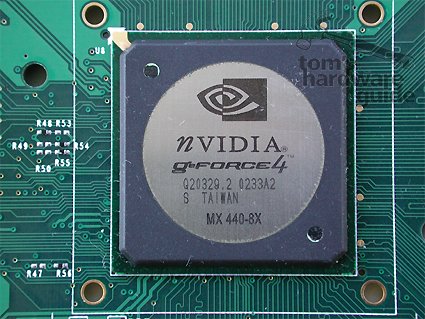NV18 & NV28: NVIDIA Chips with AGP-8x Flavor
Introduction, Continued
Current games run just fine with AGP 4x. Even when limited to the slower AGP 2x, most cards don't take much of a performance hit. There are several reasons for this. Aside from the design of a games 3D engine and its efficiency, the 3D performance of a graphics chip also plays a major role, as it has to be capable of processing all the data it is being fed. While the cardmakers would like us to think that insane amounts of polygons and huge textures need to be transferred via the AGP bus, that isn't quite in line with reality. After all, a chip like the GeForce4 MXwith its theoretical peak polygon count of 34M triangles/s would never be capable of rendering a scene as complex as that in our example. This is also the reason why we haven't seen such intricate scenes in any games yet.
Even offloading textures from a card's on-board memory to system RAM AGP 8x isn't much help, as its 2.1 GB/s are nowhere near the bandwidth modern cards are able to sustain on their own. Take the GeForce4 MX440-8x or Ti4200-8x, for example. Each offers memory bandwidth around 8 GB/s. The new Radeon 9700 PRO offers more than twice that - roughly 20 GB/s. So we see that even if a game were to use such a large texture set, AGP 8x would be less help than hindrance, creating a bottleneck and throttling performance. Since cards with less than 64 MB are a now dying breed, this scenario is unlikely to occur, even with a memory hog like FSAA enabled, and 128 MB cards are as good as immune to memory constraints anyway. That kind of capacity will hardly be needed until the next generation of true DirectX 9 games with their extensive effects hits the shelves - and maybe not even then.
Okay, that covers the theory. To find out what AGP 8x offers in the real world, we conducted a few tests with the new NVIDIA cards and pitted them against their predecessors. Since the "old" MX is clocked lower than the new model, we raised its clockspeeds to identical levels to see how much of a performance advantage AGP 8x would have over AGP 4x.
| GPU | Core | Memory |
|---|---|---|
| GeForce4 MX420 | 250 | 400 |
| GeForce4 MX440 | 270 | 400 |
| GeForce4 MX460 | 300 | 550 |
| GeForce4 Ti4200 (64 MB] | 250 | 500 |
| GeForce4 Ti4200 (128 MB] | 250 | 444 |
| GeForce4 Ti4400 | 275 | 550 |
| GeForce4 Ti4600 | 300 | 650 |
| GeForce4 Ti4200-8x (64&128 MB] | 250 | 500 |
| GeForce4 MX440-8x | 275 | 500 |
Official NVIDIA card clockrates in MHz.
All AGP 8x cards are fully downward compatible. If a motherboard "only" has an AGP 4x interface, the cards will recognize this and behave like any normal AGP 4x card. Currently, only VIA's KT400, SIS's 648, and NVIDIA's nForce 2 chipsets offer AGP 8x functionality. Therefore, we ran our tests on a SIS 648 board with a Pentium 4 2.2 GHz.
Get Tom's Hardware's best news and in-depth reviews, straight to your inbox.
